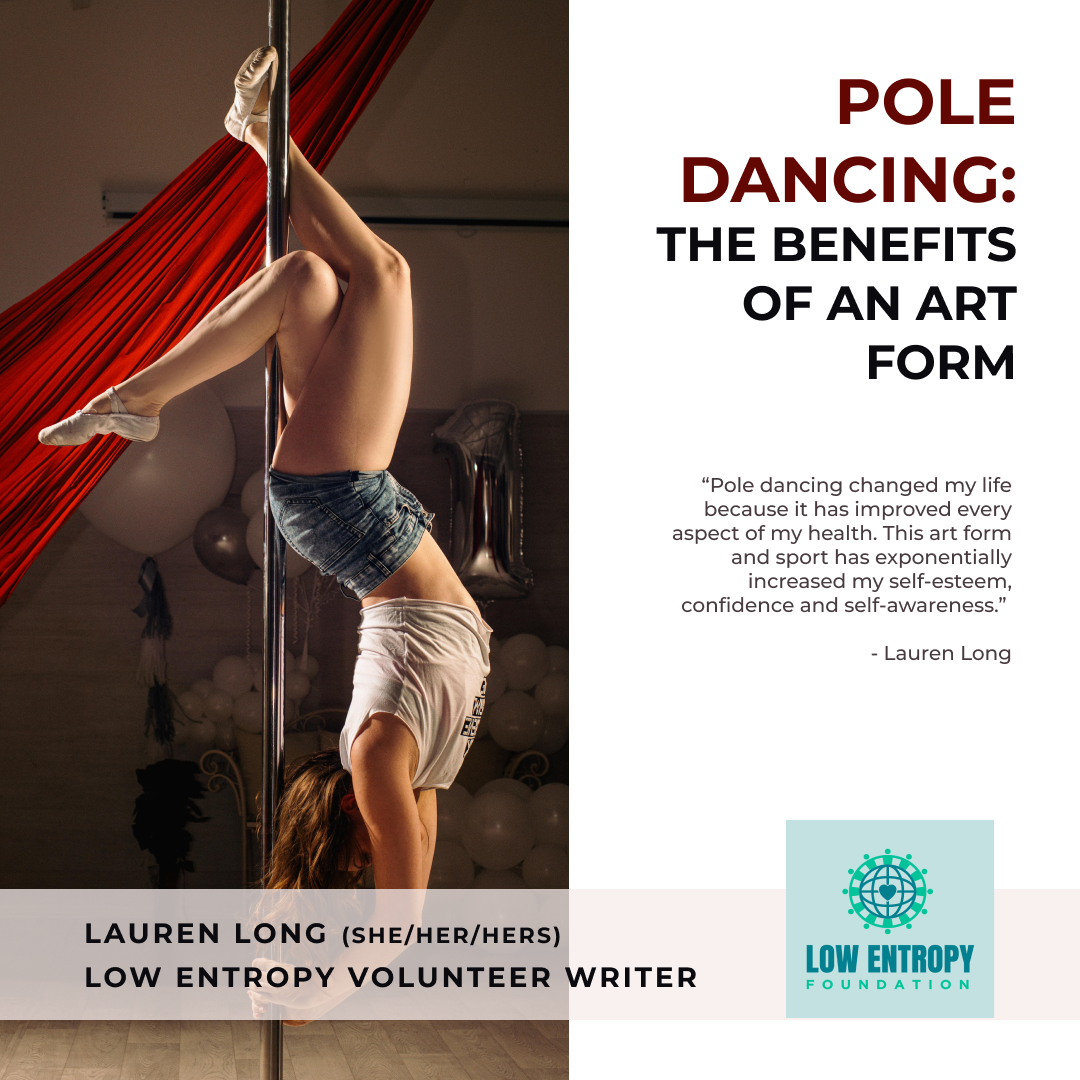Pole Dancing: The Benefits of an Art Form
April 19, 2024

Lauren Long (she/her/hers), Low Entropy Volunteer Blog Writer
Had I tried to write this piece a few years ago, I likely would have written mumbo jumbo for the first draft before scrapping it and starting again. Just as the tricks and spins I learn and train on the pole take some time to grasp, it takes more than one pole dancing session to look past the physical movements and notice the emotional and mental aspects as well.
We’ll get to how the art form of pole dancing benefits your overall well-being shortly, but before we dive into that, let me give you a brief summary of my pole journey and how I got started.
When I was in university, a friend of mine had a pole in her dorm and she invited me to come and try it out. Despite having no upper body strength whatsoever, I immediately fell in love with the pole, but didn’t think about it again until 2019, when I signed up for a choreography class in my hometown. Shortly after, I bought my own pole and I just had my four-year pole-versary (pole anniversary) in October 2023. I am fully immersed in the pole dancing world, so much so that I have led The Empowered Pole Dance Project since 2022, where I interview pole dancers about how pole dancing in all aspects has had a positive impact on their lives. The project’s focus is to promote advocacy for all pole dancers (including strippers and other workers in the adult entertainment industry), break down the stigma around pole dancing and raise awareness of the mental and physical health benefits of this sport and art form.
Okay, now that I’ve given you some background on my pole dancing journey, let’s jump into those mental and physical health benefits I mentioned. There isn’t a lot of literature about pole dancing, but that is slowly changing. I know several pole dancers who have written and published pole dancing books, and who create and host pole dancing podcasts.
My good friend Irina Kartaly wrote and published Pole Dance Fitness: The Complete Book in 2018, and her book is the first I bought on my pole journey. This turned out to be a saving grace when the COVID-19 pandemic rocked the world in 2020.
The mental health benefits of pole dancing include the improvement of social skills, emotional health, perception, memory and kinesthetic awareness. Neurologically, pole dance has demonstrated positive results in the brain’s prefrontal cortex, which comprises the skills of multifaceted thinking, cognition and multi-tasking. Other parts of the brain involved in the neurological benefits of pole dancing include the frontal lobe, which governs relaxation, thoughts and emotions, as well as the parietal lobe.
The parietal lobe is essential for successful progressions in visualization and spatial awareness. Finally, the hippocampus ties everything together by being in charge of the memory, which we need to remember the long list of movements, step sequences and choreography in dance routines.
Because our mental and physical health goes hand-in-hand, a shared benefit of pole dance between the two is the emotional release and expression that comes with the freeing of cortisol, the stress hormone. There is no better way to express your emotions than through dance, and I can attest to that. I can be in a bad mood when I head to my pole area in our basement, and by the time I come upstairs I’m a different person.
Pole dancing changed my life because it has improved every aspect of my health. This art form and sport has exponentially increased my self-esteem, confidence and self-awareness. On the physical side of things, I have developed and toned muscles in every area of my body. Pole dancing is a bodyweight training exercise because you rely on your bodyweight and muscles to support yourself.
In addition to building muscle, pole dancing causes noticeable weight loss and increases endurance while correcting posture, improving the suppleness of the skin, and preventing varicose veins and osteoporosis.
Finally, pole dancing has been shown to be valuable in all stages of pregnancy. There are women who, with clearance from their doctor, have pole danced until their due date. Because pole dance requires the strength of the abdominal and back muscles, this makes for easier pregnancy, labour, delivery and after-birth recovery.
Give pole dancing a try, and you will be amazed by its transformative power.
—
Lauren Long is from Quesnel, BC, where she was born and raised. When she’s not writing, you can find her on the training mats or curled up with a good book. She is a strong advocate for mental health and overall wellbeing.
One thought on “Pole Dancing: The Benefits of an Art Form”
Leave a Reply
GET INVOLVED
At Low Entropy, we believe changing the world starts with changing ourselves.
Founded in 2015, Low Entropy Facilitates conversations that encourage diversity and promote inclusivity.
We understand that life can be confusing at times. It can seem challenging and sometimes you may feel like no one really “gets you.” We offer an opportunity to connect with others who have the capacity to understand you.










This is amazing. We have an Aerial training facility in South Florida and would love to talk with u and anytime your down here please come by. Cohesive Movement Center. Look us up on social media or email us at info@cohesivemovementcenter.com
Much love, Rosie Wandell Owner CMC